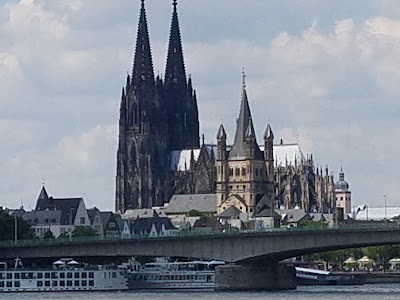Throughout the Middle Ages it was the largest German city and an important cultural and religious center. It is famous for its toilet water: Eau de Cologne was first made here by an Italian chemist in 1709.
The twin-spired Gothic church that can be seen from nearly anywhere in the city is the Hohe Domkirche St. Petrus--a Catholic Cathedral, seat of the Archbishop, and Germany's most visited landmark.
During World War II, the Allies bombed Cologne hard in retaliation for Germany's bombing of London.
 |
| Cologne, 1945 |
The bombs destroyed 95 percent of the city. It was rebuilt in mostly modern style, except for the "old town", which was rebuilt in the old style.
We peeked through the Roman-Germanic Museum's window for a look at a beautifully preserved mosaic floor, once the dining room floor of a rich Roman merchant.
The cathedral--the most ambitious Gothic building project north of France in the 13th century--was stalled in the Middle Ages and not finished until 1880.
We had hoped to tour the inside of the cathedral but there was a service going on and all we could do was stand at the back of the nave and admire the 140-foot tall ceiling and the stained-glass windows, which fills the church with light.
In centuries past, a clutter of half-timbered huts crowded around the outside of the cathedral. They were all cleared out in the late 1800s so the great building would have a suitable approach to the entrance.
The Roman arch was discovered nearby and set up outside the cathedral as a reminder of the town's Roman roots.
There is an excavation site within the cathedral that shows the foundations from the cathedral's predecessor.
At the end of our walking tour, our Program Director, Wes, treated us all to some local beer at a bier haus.
We sat with Roger, Shellee, Mary and Michael.
We then left our group to find a pharmacy and buy some cold meds. Joyce's cold has taken a turn for the worse.
It was the most unusual pharmacy we had ever seen. No product on shelves. Behind the counter were computer screens with various ailments listed. With the help of the pharmacist we narrowed down the symptoms and chose a product pictured on the screen. Then with a push of a button by the pharmacist, the product came from behind the wall on a conveyor belt so we could purchase it.
After lunch on the ship, Terry returned to the cathedral to climb the 509 steps up the south tower's spire. Joyce stayed on the ship and let the cold meds do its job.
There are 9 huge bells; one called Deicke Peter (24-ton Fat Peter) claimed to be the largest free-swinging bell in the world.
From the top of the spire, there were great views of the city of Cologne.
And back down from the climb, Terry found a bier haus with a great view and a refreshing drink.
We missed seeing the highlights of the interior of the cathedral--the Gero-Crucifix, the Shrine of the Magi, and the Madonna of Milan....guess we will just have to return to Cologne some day!
We have one more posting for this trip. To continue reading, scroll up towards the top of this page and click in the right-hand column the entry entitled: "Amsterdam, the Netherlands, and our cruise comes to an end".

























No comments:
Post a Comment